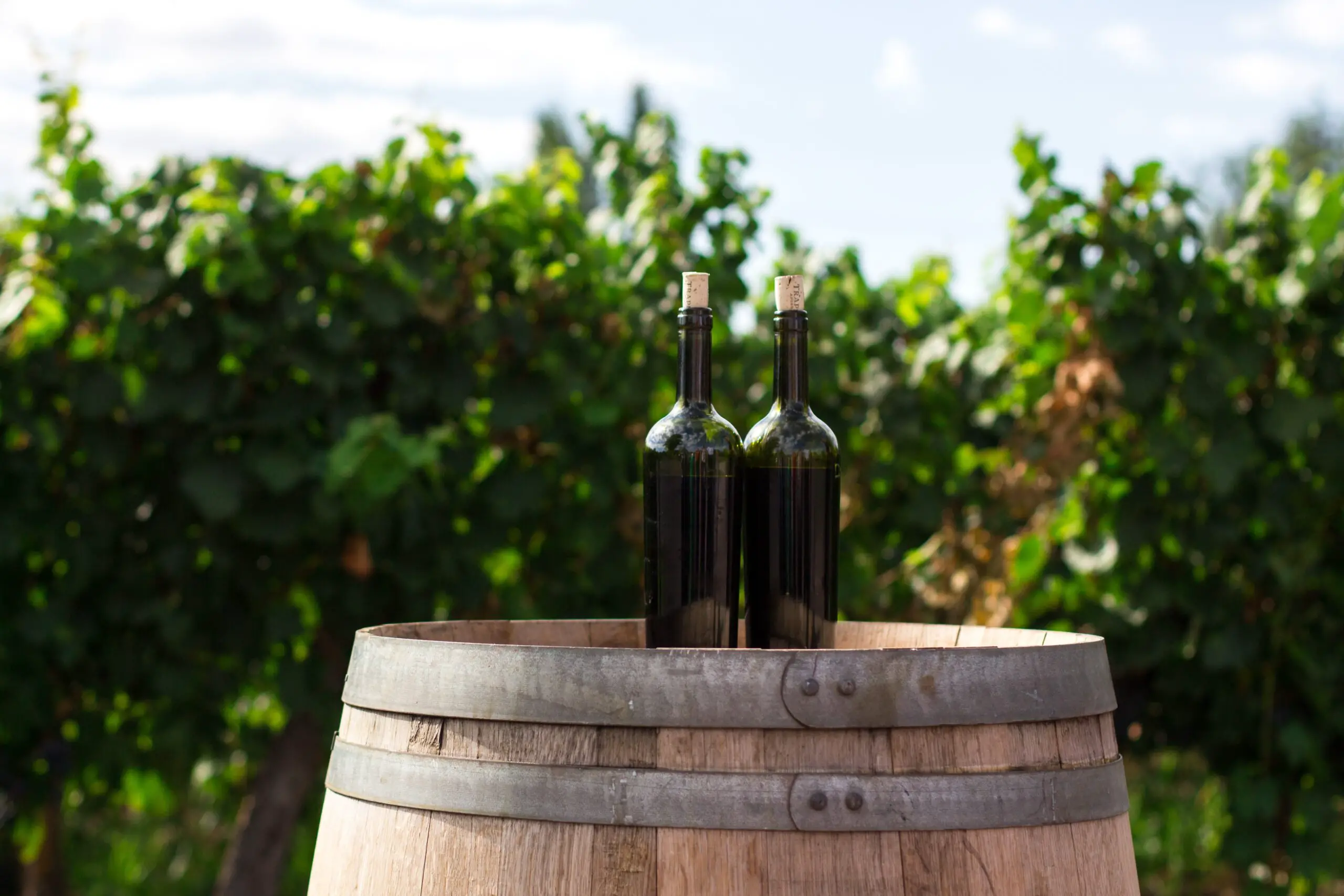There are no less than six different wine valleys where you can go for the day from Santiago. While Colchagua Valley is the most famous of the three, Casablanca Valley and Maipo Valley are the most visited. But what about the other three? Well, there are some great finds there. Here are my recommendations for each valley.
Table of Contents
Maipo Valley:
The closest wine valley from Santiago, Maipo is perhaps my least favorite. Let me start with a warning: please do yourself a favor, and do NOT visit Concha y Toro! Yes, I know, this is the most famous winery in Chile – partly because their logo is on the jersey of Manchester United, one of Europe’s most prominent soccer clubs; and partly because it is the country’s largest wine producer, by far.
And since it is the most well-known, it is also the most visited. And that’s exactly why you don’t wanna go there: they offer large group tours where you cannot hear anything if you are not close enough to the guide, and you get to taste average wines – unless you pay a hefty price for a premium and/or private tour.
Instead, I would recommend the following:
Viña Santa Rita:
A great place to start your discovery of the Chilean wine industry. Santa Rita is also a rather large and touristy winery, but it will give you a nice experience: you get to see a typical old colonial building from the 1800’s with a beautiful garden, they have a good restaurant, an important episode of Chilean History took place right there in their cellar, and they have great collections of antiques, gold and Pre-colombian arts in their museum.
Viña Di Martino:
A very innovative winery, where they experiment with old clay pots instead of the typical barrels, producing biodynamic wines and some very unusual reds. Not the best place to visit if you have never been to a winery before, but definitely interesting.
Some other nice wineries to visit in Maipo Valley that are not too touristy include Haras de Pirque, which features beautiful architecture and is themed around horses, and Odfjell, founded by a Norwegian family and producers of some excellent reds. These last two are a little bit more high-end, but still affordable.
Additional tip:
The only complicated thing with Maipo Valley is that most wineries are closed to visitors on Sunday, and only some of them open on Saturday. And it is also necessary to book in advance for most of them – if you intend to just walk in there, they might be unable to receive you.
Aconcagua Valley:
To me, that’s the hidden gem. Although Aconcagua Valley is the place where Errazuriz, Seña and Chadwick are produced (the three of them being widely recognized as some of the best high-end wines in South America), it does not receive a lot of visitors. Merely because apart from these three brands, all produced by Errazuriz, there are mostly small, family-owned vineyards there. Besides, tourism has never been heavily promoted in the valley, until recently.
Here are my three favorites wineries to visit in Aconcagua Valley:
Sanchez de Loria:
They may not produce the best wine in the valley, but their tour is the most unique you will find in the area. Sanchez de Loria is an 140-year-old, family-owned winery, where everything from the past has been kept, and is still in use: gigantic oak barrels, old presses, ancient tools… I like to say that this is like entering a wine museum, except that everything is working! It really makes for a unique experience to sit there in this old family house and drink their wine. Like a short journey to the past.
Flaherty’s:
My favourite winery in the valley. Founded and owned by a Californian winemaker who came to Chile to develop new varieties, it is a very small, very artisanal winery, but they produce really nice reds – plus, their tour guide is both humorous and informative. And if you book beforehand, you can have a delicious meal paired with their wines, prepared by the owner’s wife Jennifer, who will cook local recipes made with local ingredients and spices from her garden! I have done my fair share of wineries’ restaurants in Chile: Flaherty’s is hands down the place where I have had the most delicious, most intimate experience.
Viña San Esteban (aka VSE, aka In Situ):
Granted, these guys are probably not the best in branding, given that they go by three different names. But they have some really interesting features there: their flagship is produced high enough in the mountains that it actually snows there, they have an Inca archeological site (picture below) in the middle of the vineyard that you can visit, and they also have a workshop where you can make your own bottle of wine. And it’s not touristy at all!
Casablanca Valley:
Probably the most visited wine valley in Chile, due to its location between the capital and the UNESCO city of Valparaiso. While Casablanca is famous for its white wines, there are also some great reds there, such as Pinot Noir and Syrah. Besides, most of the wineries that you can visit in Casablanca also bring red grapes from the warmer valleys of Maipo and Colchagua, so that they can produce both high-quality whites and high-quality reds.
Last time I checked, there were closed to 20 wineries that were open to visitors. If you want to avoid the most crowded ones with the big buses, here are my recommendations:
Villard Fine Wines:
Half-French, half-Chilean, the Villard family brings the best of two worlds: the French tradition, and the Chilean innovation. Their line of red wines is excellent for their value, and they are located in possibly the most beautiful part of Casablanca Valley, right in front of the mountain range.
Bodegas RE:
Probably the most innovative winery in Chile, and my personal favorite (I have a thing for innovation). Their concept is simple: recreate, reinvent, revolutionize. They took very ancient winemaking techniques, mixed them with state-of-the-art technology (picture below), and now produce wines that are unique and different. And they also experiment with fruit liquors, olive oil and balsamics. A truly special visit.
The Brazilians:
Brazil is known for coffee, not for wine. However, Chilean wine is really popular with Brazilians, and a few of them have decided to move here to make their own wine. Their respective brands, Attilio & Mochi and La Recova, are now considered as two of the best in Casablanca Valley. Both have very small wineries that they built themselves with a lot of ingenuity, and they make their wines using their creativity, away from the usual recipes and techniques. Some of their experiments don’t really work out, but some others, like Attilio & Mochi’s reds and La Recova’s rosé, are great hits. Highly recommended to visit (necessary to book beforehand).
San Antonio Valley:
Right next to Casablanca Valley, but closer to the ocean, San Antonio Valley is the place for crisp, light white wines. Not many wineries are open to visitors there, but one of them is definitely worth the trip: Casa Marin. The founder Mari-Luz Marín is a pioneer. First, because she is the first woman to found a winery in Chile; second, because never before had anybody dared to plant vines so close to the Pacific ocean. The result: one of the best white wines in Chile. Casa Marin also rents a couple of lovely cabins for the night, and has its own restaurant.
Cachapoal Valley:
Although it’s right there on the way between Santiago and Colchagua Valley further South, this particular wine region is very rarely visited. Just like their colleagues from Aconcagua Valley, the vineyards’ owners in Cachapoal have never put an emphasis on tourism. As such, only a handful of wineries are open to visitors.
My recommendation? If you have only one day, just do like everybody else and drive through until you get to Colchagua Valley. If you have more time, at least two wineries are worth a visit: the traditional, family-owned Clos de Luz, where you will also discover the unique irrigation system with old wooden wheels, and the luxurious Viña VIK (picture below), which has an extraordinary architecture and luxurious design hotel.
Colchagua Valley:
That’s the most famous wine valley in Chile. First of all, because this where most of Chile’s high-end wines are produced. And second, because their association of producers was the first one to decide to impulse tourism, back in the 1990’s.
Here again, I would recommend you to avoid the crowds at Viu Manent or Viña Santa Cruz. Instead, I would suggest:
Viña Montgras:
Their wine is good, their staff is very friendly and they take really good care of their visitors. Also, they offer a wide range of interesting wine experiences, including blind tasting and an activity to create your own blend. And surprisingly, not too many tourists go there. I still can’t figure out why!
Viña Laura Hartwig:
There, you will find a traditional-style winery, where you can go on a tour in an old carriage, and also try some of the better wines of the valley. Possibility to do a picnic as well.
– And if you are interested in top-quality wines, Viña Montes and Viña Lapostolle are your best options. Montes has an excellent restaurant, probably the best in the valley. And Lapostolle (also known as Clos de Apalta) has a very exclusive and expensive residence overlooking the valley.
Finally, if you can spend a night there
It’s really worth it to visit the Museum of Colchagua, the largest private museum in Chile. There is a bit of everything there, from ancient pieces from the pre-Inca civilizations to modern pieces of History. But the star of the show is one of the cabins that were used to rescue the 33 miners that remained trapped underground for 2 months, in the North in Chile, in 2010.
Wines and pisco
If you would like to explore more about the wine regions in Chile, there is actually a lot more than these six. From the desert Atacama region (700 kms North of Santiago) to the rainy Araucania region (600 kms in South of Santiago), Chile hosts a great variety of wine regions, with very different climates – and thus, very different types of wines.
In fact, if you go to the North to Atacama and Coquimbo regions, you will not find that much wine there – not very good one, anyway. What these two areas are famous for is pisco, the national drink which is essentially a distillate of grapes. But that’s for another article.
And if you go South, you will find cool climate valleys such as Itata and Bio-Bio. But very few places are open to visitors there.
Final recommendations
- In Chile, there is zero tolerance with alcohol and driving. It is necessary to have a dedicated driver, or to take a tour.
- Also, it is highly recommended to book your wine tours in advance, even at the larger wineries.

Avid traveler, journalist and writer, he moved away from his native France back in 2006 and settled in Chile. After visiting the country North to South, learning extensively about its culture, History, gastronomy, Thomas started to work as a tour guide. He liked it so much that he ended up creating his own tour agency in Valparaiso, where he lives today. You can visit my site at: https://chileprivatetours.com/
